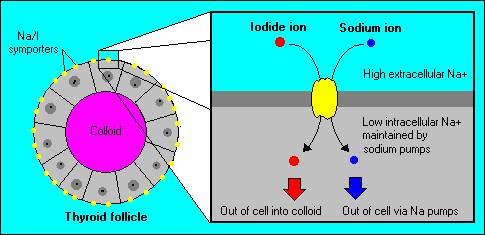Physiologic and Pathologic Significance
The ability of the thyroid gland to transport and concentrate iodide from blood is absolutely necessary for the synthesis of thyroid hormones. The key player in this process is the sodium-iodide symporter, an integral membrane protein that resides in the basolateral membrane of thyroid epithelial cells.
Considering critical role of iodine trapping in thyroid function, it is not surprising that abnormalities in expression or function of the symporter can lead to thyroid diesase. Two such situations have been identified in humans:
- Inactivating mutations in the symporter gene result in congenital hypothyroidism. In several patients with this disorder, specific missense mutations in the symporter mRNA have been characterized.
- Autoantibodies to the symporter protein adversely affect iodide transport. A substantial number of patients with autoimmune (Hasimoto's) thyroiditis have anti-symporter antibodies, and application of these antibodies to cultured cells expressing the symporter inhibits iodide uptake.
The sodium-iodide symporter cannot distinguish between normal and radioactive iodide, thus providing a useful exploit for diagnosis and treatment of certain thyroid disease. Small amounts of radioactive iodine injected into patients are rapidly concentrated in the thyroid, providing a means to image the thyroid for detection of tumors and other abnormalities. Administration of higher doses of radioiodine is widely used for treatment of hyperthyroidism and some types of thyroid cancer; in this case the radioactivity is concentrated rather precisely in the tissue requiring destruction.
Structure and Function
As its name indicates, the sodium-iodide symporter simultaneously transports both Na+ and I- ions from extracellular fluid (i.e. blood) into the thryoid epithelial cell. This process is an example of secondard active transport. Energy is provided by the electrochemical gradient of sodium across the cell membrane; the low intracellular concentration of sodium is maintained by sodium pumps.

Recently, cDNAs for the rat and human sodium-iodide transporter have been cloned. Analysis of their deduced protein sequence indicates that the symporter has 13 membrane-spanning domains. The human and rat proteins are 643 and 618 amino acids in length and both contain N-linked glycosylation sites. Although the symporter appears to be glycosylated, those modifications are appearently not required for full activity. The functional receptor may be a multimer.

Regulation of Expression
The sodium-iodide symporter is most highly expressed in thyroid epithelial cells. Lower levels of expression can be detected in mammary gland, salivary gland, stomach and colon, but none of these tissues is known to organify iodide. The presence of the symporter in mammary gland leads to secretion of iodine in milk, which is probably important for thyroid function in neonatal animals.
The most important stimulator of symporter gene and protein expression is thyroid-stimulating hormone, similar to what is observed with other important thyroid proteins such as thyroglobulin and thyroid peroxidase.
The human sodium-iodide symporter gene has 15 exons. It has a basal promoter region that extends roughly 500 bp upstream from the transcription start site and thyroid-specific enhancer elements that span positions of approximately -2200 to -2500.
 References and Reviews References and Reviews
- Dai G, Levy O, Carrasco N: Cloning and characterization of the thyroid iodide transporter. Nature 379:458, 1996.
- De la Vieja A, Dohan O, Levy O, Carrasco N: Molecular Analysis of the Sodium/Iodide Symporter: Impact on Thyroid and Extrathyroid Pathophysiology. Phys Rev 80:1083-1105, 2000.
- Dohan O, De la Vieja A, Paroder V, etc: The sodium/iodide symporter (NIS): Characterization, regulation and medical significance. Endocrine Reviews 24:48-77, 2003.
- Fugiwara H, Tatsumi K, Miki K et al: Congenital hypothyroidism caused by a mutation in the Na+/I- symporter. Nature Genetics 16:124, 1997.
- Spitzweg C, Heufelder AE: The sodium iodide symporter: its emerging relevance to clinical thyroidology. Europ J Endocrinol 138:374, 1998.
|



 References and Reviews
References and Reviews